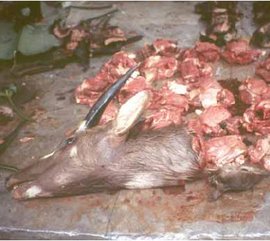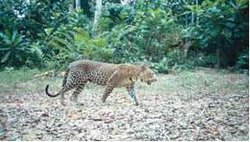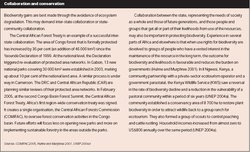Central Africa and biodiversity
Contents
- 1 Overview of resources Table 1: The biodiversity features of Central Africa (Source: Groombridge and Jenkins 2002, Hoekstra and others 2005, Mayaux and others 2004 and WRI 2005) The vast equatorial forests of the Congo basin, which dominate Africa’s tropical realm, contain a huge variety of life (Table 1). Due to its inaccessibility and a history of conflict, its ecology remains poorly studied. Within Central Africa, only Chad does not contain tropical rain forest, while in Cameroon, Central Afican Republic (CAR) and the Democratic Republic of Congo (DRC) rain forest transitions from evergreen forest to deciduous forest, to wooded, open, and Sahelian savannahs, each transition signifying a huge shift in species composition and diversity. Plant diversity is high, with well over 10,000 species, 8,000 of which are found in the forest zone, of which 80 percent are endemic. Three of the four species of great ape, the closest evolutionary relative to humans, still occur. The subregion has the highest primate diversity in Africa. The Congo River is the second largest river system on Earth, containing at least 669 species of fish, many of which are important sources of protein for the local population. (Central Africa and biodiversity)
- 2 Challenges faced in realizing opportunities for development
- 3 Strategies to enhance the opportunities for development
- 4 Further reading
Overview of resources Table 1: The biodiversity features of Central Africa (Source: Groombridge and Jenkins 2002, Hoekstra and others 2005, Mayaux and others 2004 and WRI 2005) The vast equatorial forests of the Congo basin, which dominate Africa’s tropical realm, contain a huge variety of life (Table 1). Due to its inaccessibility and a history of conflict, its ecology remains poorly studied. Within Central Africa, only Chad does not contain tropical rain forest, while in Cameroon, Central Afican Republic (CAR) and the Democratic Republic of Congo (DRC) rain forest transitions from evergreen forest to deciduous forest, to wooded, open, and Sahelian savannahs, each transition signifying a huge shift in species composition and diversity. Plant diversity is high, with well over 10,000 species, 8,000 of which are found in the forest zone, of which 80 percent are endemic. Three of the four species of great ape, the closest evolutionary relative to humans, still occur. The subregion has the highest primate diversity in Africa. The Congo River is the second largest river system on Earth, containing at least 669 species of fish, many of which are important sources of protein for the local population. (Central Africa and biodiversity)
Challenges faced in realizing opportunities for development
Biodiversity faces various threats, including increasing trade. Although forest elephants, gorillas, forest buffalo, bongo, okapi and giant forest hogs continue to live in large numbers in Central Africa’s forests, these species and their habitat face an uncertain future. Forest elephants once roamed over most of the nearly 2 million km2 of the Congo basin forest. Considerable evidence, including that from landscape scale inventories by the Monitoring of the Illegal Killing of Elephants program (MIKE) of the Convention on International Trade in Endangered Species (CITES), suggests that the elephant range has been dramatically reduced due to illegal killing for ivory and bushmeat, as well as increasing human encroachment into forest lands. Elephants may be increasingly confined to protected areas and their immediate peripheries. Great apes face similar challenges, with the added spectre of disease, such as Ebola, reducing populations to a fraction of their original abundance.
The logging industry dominates land use and the economy in forested areas. Since its coastal beginnings, in colonial times, logging has spread to the deep interior of the forest. Logging is mostly selective due to high production costs. Canopy damage is typically 10-20 percent, meaning that forest cover remains post-logging, but the forest ecology is significantly modified. Furthermore, logging and logging roads bring immigration into formerly remote areas, opening up the interior to use, stimulating the development of cash economies, and allowing access to distant markets.
 The bushmeat trade comes with both costs and benefits. It offers nutrition for many poor people, but at times threatens biodiversity. Cameroon.
The bushmeat trade comes with both costs and benefits. It offers nutrition for many poor people, but at times threatens biodiversity. Cameroon.(Source: CARPE)
The expansion of bushmeat hunting is a major threat: between 1 and 5 million tons is harvested annually, well above sustainable levels. Casualties of the bushmeat trade include the great apes (gorillas, chimpanzees, and bonobos), which coupled with the real and growing threat from the Ebola virus could be driven to the verge of extinction within a decade. With limited national capacity for sustainable land-use planning and law enforcement, logging has become a major vehicle for a dramatically expanding illegal bushmeat trade to supply local, national and international commercial markets. Recognizing the seriousness of the threat, efforts are underway toward sustainable management of the main bushmeat species, and to promote alternative sources of protein in logging concessions and other rural and urban settings, and to diversify incomes for bushmeat hunters.
The use of bush fires in the clearing of land for agriculture and settlement as well as a hunting technique is the second major threat to biodiversity resources. Slow-growing species at the edge of the forests are disappearing and gradually being replaced by pioneer species. Regeneration of slow-growing species, which have high value timber, requires long fallow periods, which is often not allowed by the bush fires. There is therefore a risk of forest areas disappearing and being replaced by savannah.
Inter-basin transfers of water pose several threats to biodiversity. For example, proposals have been made to divert large volumes of water from the Ubangui River (part of the Congo River basin) northwards through the CAR and Chad, and to discharge this water into the Logone-Chari rivers feeding Lake Chad. The proposed water transfer would have the effect of dramatically increasing the flooded extent of Lake Chad and restoring livelihoods of residents living along its shorelines, most of whom subsist on products from their livestock and on blue-green algae and fish harvested from Lake Chad, but runs the risk of transferring an unrelated set of species into the Lake Chad basin. These proposals also suggest that a scheme to divert water from the Ubangui River could be enlarged sufficiently so that additional water could be diverted via a pipeline further northwards into southern Libya. Whilst such water transfers could enhance the biodiversity of Lake Chad and its immediate surroundings, there is a strong possibility that such a scheme could have significant adverse effects on the Congo River system to the south.
Strategies to enhance the opportunities for development
Sustainable and equitable natural resource management is the key not just to the maintenance of biodiversity but equally to human development and well-being. Conservation and wildlife management has lagged behind the rest of the region, though one of Africa’s first national parks, the Virunga National Park, was created here in 1925. The costs of conservation are far from trivial. It is estimated that successful management of a minimal network of protected areas in forests alone would require an investment of over US$1,000 million over 10 years, followed by recurrent costs of nearly US$90 million per year; current investment is probably about US$15 million per year.
Much of the remaining biodiversity is held outside national parks. Thus, broadscale resource management systems which combine protected areas with areas of increasing human use can be an important intervention. Initiatives such as the Yaoundé Process, which led to the Yaoundé Declaration in 1999, made a formal commitment to the conservation and sustainable management of tropical forests, and helped catalyse the Plan de Convergence, the creation of Gabon’s network of 13 national parks, and the Congo Basin Forest Partnership (CBFP), consisting of 27 public and private partners. USAID’s Central Africa Regional Project for the Environment (CARPE) and the European Commission’s Ecosystems Forestiers d’Afrique Centrale (ECOFAC) contribute to this partnership. An important task for the CBFP is the development of a monitoring system to provide a periodic assessment of the forest and biodiversity of the Congo basin (see Box 1).
Further reading
- Bikié, H., et al., 2000. An Overview of Logging in Cameroon.A Global Forest Watch Cameroon Report. World Resources Institute, Washington, D.C.
- Blake, S., 2002. The Ecology of Forest Elephant Distribution and its Implications for Conservation. Ph.d Thesis. University of Edinburgh, Edinburgh.
- Blom, A., 2004. An estimate of the costs of an effective system of protected areas in the Niger Delta – Congo Basin Forest Region. Biodiversity and Conservation. 13(14), 2661-78.
- CBFP (undated). Partenariat pour les forets du Bassins du Congo. Congo Basin Forest Partnership.
- CBFP, 2005. The Forests of the Congo Basin: A Preliminary Assessment. The Congo Basin Forest Partnership.
- Champan, L.J., 2001. Fishes of African Rainforests: Diverse Adaptations to Environmental Challenges. In African Rainforest Ecology and Conservation (eds. Morland, H.S.,Vedder,A.,Weber,W., and White, L.), pp 263-90. Yale University Press, New Haven.
- Collomb, J-G., et al., 2000. A First Look at Logging in Gabon. A Global Forest Watch Gabon Report.World Resources Institute, Washington D.C.
- COMIFAC, 2005. Le Plan de Convergence,Tradition et Modernité: Une plate-forme commune d’actions pour le Bassin du Congo. Central African Forests Commission.
- Gabon National Parks (undated). Gabon National Parks: Presenting the wonder of Gabon’s wildlife.
- Harcourt, A.H., 2000. Coincidence and mismatch of biodiversity hotspots: a global survey for the order, primates. Biological Conservation. 93(2), 163-75.
- Hoekstra, J.M., Boucher, T.M., Ricketts,T.H. and Roberts, C., 2005. Confronting a biome crisis: global disparities of habitat loss and protection. Ecology Letters. 8, 23-9.
- Kuwairi, A.S., 2004. The Great Man-Made River Project. Proceedings of the 7th Pan African Water Conference, 29-30 November, Sandton, South Africa.
- Mayaux, P., Bartholomé, E., Fritz, S. and Belward, A., 2004. A new landcover map of Africa for the year 2000. Journal of Biogeography. 31(6), 861-77.
- Robinson, J.G. and Bennett, E.L., 2002. Will alleviating poverty solve the bushmeat crisis? Oryx. 36, 332.
- Robinson, J.G. and Bennett, E.L., 2004. Having your wildlife and eating it too: an analysis of hunting sustainability across tropical ecosystems. Animal Conservation. 7, 397-408.
- Sayer, J.A., Harcourt, C.S. and Collins, N.M. (eds. 1992). The Conservation Atlas of Tropical Forests: Africa. MacMillan, London.
- UNEP, 2004a. Africa Environment Outlook, Case Studies:Human Vulnerability to Environmental Change. United Nations Environment Programme, Nairobi.
- UNEP, 2006. Africa Environment Outlook 2
- Walsh, P.D., et al., 2004. Catastrophic ape decline in western equatorial Africa. Nature. 422(6932), 611-4.
- White, L.J.T., 2001. The African Rainforest: Climate and Vegetation. In African Rain Forest Ecology and Conservation (eds.Weber,W., White, L.J.T., Vedder,A. and Naughton-Treves, L.), pp 3-29. Yale University Press, New Haven.
- Wilkie, D., Shaw, E., Rotberg, F., Morelli, G. and Auzel, P., 2000. Roads, development, and conservation in the Congo Basin. Conservation Biology. 14, 1614-22.
- WRI, 2005. EarthTrends: The Environmental Information Portal. World Resources Institute, Washington, D.C.
|
|
| Disclaimer: This article is taken wholly from, or contains information that was originally published by, the United Nations Environment Programme. Topic editors and authors for the Encyclopedia of Earth may have edited its content or added new information. The use of information from the United Nations Environment Programme should not be construed as support for or endorsement by that organization for any new information added by EoE personnel, or for any editing of the original content. |

